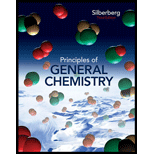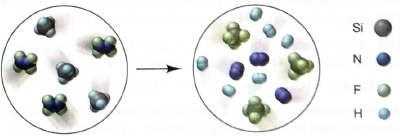
Principles of General Chemistry
3rd Edition
ISBN: 9780073402697
Author: SILBERBERG, Martin S.
Publisher: McGraw-Hill College
expand_more
expand_more
format_list_bulleted
Concept explainers
Textbook Question
Chapter 3, Problem 3.100P
Write a balanced equation for the reaction depicted below:

If each reactant molecule represents
Expert Solution & Answer
Want to see the full answer?
Check out a sample textbook solution
Students have asked these similar questions
Provide solutions
Which of these compounds is Ester formed from the reaction of acetic acid and one propanol 
Describe the four labeled parts of the reaction diagram from the reaction of sucrose, breaking down with and without an enzyme.
Chapter 3 Solutions
Principles of General Chemistry
Ch. 3 - The atomic mass of Cl is 35.45 amu, and the atomic...Ch. 3 - (a) How many moles of C atoms are in 1 mol of...Ch. 3 - Prob. 3.3PCh. 3 - How is the molecular mass of a compound the same...Ch. 3 - What advantage is there to using a counting unit...Ch. 3 - Prob. 3.6PCh. 3 - Prob. 3.7PCh. 3 - Calculate the molar mass of each of the following:...Ch. 3 - Prob. 3.9PCh. 3 - Calculate the molar mass of each of the following:...
Ch. 3 - Prob. 3.11PCh. 3 - Calculate each of the following quantities: (a)...Ch. 3 - Prob. 3.13PCh. 3 - Prob. 3.14PCh. 3 - Prob. 3.15PCh. 3 - Calculate each of the following quantities: (a)...Ch. 3 - Calculate each of the following: Mass % of H in...Ch. 3 - Prob. 3.18PCh. 3 - Prob. 3.19PCh. 3 - Prob. 3.20PCh. 3 - Prob. 3.21PCh. 3 - Prob. 3.22PCh. 3 - Prob. 3.23PCh. 3 - Which of the following sets of information allows...Ch. 3 - What is the empirical formula and empirical...Ch. 3 - Prob. 3.26PCh. 3 - Prob. 3.27PCh. 3 - Prob. 3.28PCh. 3 - Prob. 3.29PCh. 3 - Prob. 3.30PCh. 3 - Prob. 3.31PCh. 3 - Prob. 3.32PCh. 3 - Cortisol (m=362.47g/mol) is a steroid hormone...Ch. 3 - Prob. 3.34PCh. 3 - Prob. 3.35PCh. 3 - Prob. 3.36PCh. 3 - Write balanced equations for each of the following...Ch. 3 - Write balanced equations for each of the following...Ch. 3 - Prob. 3.39PCh. 3 - Prob. 3.40PCh. 3 - Prob. 3.41PCh. 3 - Potassium nitrate decomposes on heating, producing...Ch. 3 - Prob. 3.43PCh. 3 - Calculate the mass of each product formed when...Ch. 3 - Prob. 3.45PCh. 3 - Prob. 3.46PCh. 3 - Prob. 3.47PCh. 3 - Many metals react with oxygen gas to form the...Ch. 3 - Prob. 3.49PCh. 3 - Calculate the maximum numbers of moles and grams...Ch. 3 - Prob. 3.51PCh. 3 - Prob. 3.52PCh. 3 - Prob. 3.53PCh. 3 - Prob. 3.54PCh. 3 - Prob. 3.55PCh. 3 - Prob. 3.56PCh. 3 - Prob. 3.57PCh. 3 - Prob. 3.58PCh. 3 - Prob. 3.59PCh. 3 - Prob. 3.60PCh. 3 - Prob. 3.61PCh. 3 - Prob. 3.62PCh. 3 - Prob. 3.63PCh. 3 - Prob. 3.64PCh. 3 - Prob. 3.65PCh. 3 - Six different aqueous solutions (with solvent...Ch. 3 - Prob. 3.67PCh. 3 - Prob. 3.68PCh. 3 - Prob. 3.69PCh. 3 - Calculate each of the following quantities: (a)...Ch. 3 - Prob. 3.71PCh. 3 - Prob. 3.72PCh. 3 - Prob. 3.73PCh. 3 - Prob. 3.74PCh. 3 - Prob. 3.75PCh. 3 - Prob. 3.76PCh. 3 - Prob. 3.77PCh. 3 - Prob. 3.78PCh. 3 - Prob. 3.79PCh. 3 - Prob. 3.80PCh. 3 - Prob. 3.81PCh. 3 - Prob. 3.82PCh. 3 - Prob. 3.83PCh. 3 - Prob. 3.84PCh. 3 - Prob. 3.85PCh. 3 - Seawater is approximately 4.0% by mass dissolved...Ch. 3 - Is each of the following statements true or false?...Ch. 3 - Prob. 3.88PCh. 3 - In each pair, choose the larger of the indicated...Ch. 3 - Prob. 3.90PCh. 3 - Prob. 3.91PCh. 3 - Assuming that the volumes are additive, what is...Ch. 3 - Prob. 3.93PCh. 3 - Prob. 3.94PCh. 3 - Hydrocarbon mixtures are used as fuels, (a) How...Ch. 3 - Prob. 3.96PCh. 3 - Prob. 3.97PCh. 3 - Prob. 3.98PCh. 3 - Prob. 3.99PCh. 3 - Write a balanced equation for the reaction...Ch. 3 - Prob. 3.101PCh. 3 - Citric acid (right) is concentrated in citrus...Ch. 3 - Prob. 3.103PCh. 3 - Prob. 3.104PCh. 3 - Prob. 3.105PCh. 3 - Prob. 3.106PCh. 3 - Aspirin (acetylsalicylic acid, C9H8O4 ) is made by...Ch. 3 - Prob. 3.108PCh. 3 - Prob. 3.109PCh. 3 - Prob. 3.110PCh. 3 - High-temperature superconducting oxides hold great...
Knowledge Booster
Learn more about
Need a deep-dive on the concept behind this application? Look no further. Learn more about this topic, chemistry and related others by exploring similar questions and additional content below.Similar questions
arrow_back_ios
SEE MORE QUESTIONS
arrow_forward_ios
Recommended textbooks for you
 Chemistry for Engineering StudentsChemistryISBN:9781337398909Author:Lawrence S. Brown, Tom HolmePublisher:Cengage Learning
Chemistry for Engineering StudentsChemistryISBN:9781337398909Author:Lawrence S. Brown, Tom HolmePublisher:Cengage Learning Introductory Chemistry: A FoundationChemistryISBN:9781285199030Author:Steven S. Zumdahl, Donald J. DeCostePublisher:Cengage Learning
Introductory Chemistry: A FoundationChemistryISBN:9781285199030Author:Steven S. Zumdahl, Donald J. DeCostePublisher:Cengage Learning Chemistry: The Molecular ScienceChemistryISBN:9781285199047Author:John W. Moore, Conrad L. StanitskiPublisher:Cengage Learning
Chemistry: The Molecular ScienceChemistryISBN:9781285199047Author:John W. Moore, Conrad L. StanitskiPublisher:Cengage Learning Chemistry & Chemical ReactivityChemistryISBN:9781133949640Author:John C. Kotz, Paul M. Treichel, John Townsend, David TreichelPublisher:Cengage Learning
Chemistry & Chemical ReactivityChemistryISBN:9781133949640Author:John C. Kotz, Paul M. Treichel, John Townsend, David TreichelPublisher:Cengage Learning Chemistry: Principles and PracticeChemistryISBN:9780534420123Author:Daniel L. Reger, Scott R. Goode, David W. Ball, Edward MercerPublisher:Cengage Learning
Chemistry: Principles and PracticeChemistryISBN:9780534420123Author:Daniel L. Reger, Scott R. Goode, David W. Ball, Edward MercerPublisher:Cengage Learning World of ChemistryChemistryISBN:9780618562763Author:Steven S. ZumdahlPublisher:Houghton Mifflin College Div
World of ChemistryChemistryISBN:9780618562763Author:Steven S. ZumdahlPublisher:Houghton Mifflin College Div

Chemistry for Engineering Students
Chemistry
ISBN:9781337398909
Author:Lawrence S. Brown, Tom Holme
Publisher:Cengage Learning

Introductory Chemistry: A Foundation
Chemistry
ISBN:9781285199030
Author:Steven S. Zumdahl, Donald J. DeCoste
Publisher:Cengage Learning

Chemistry: The Molecular Science
Chemistry
ISBN:9781285199047
Author:John W. Moore, Conrad L. Stanitski
Publisher:Cengage Learning

Chemistry & Chemical Reactivity
Chemistry
ISBN:9781133949640
Author:John C. Kotz, Paul M. Treichel, John Townsend, David Treichel
Publisher:Cengage Learning

Chemistry: Principles and Practice
Chemistry
ISBN:9780534420123
Author:Daniel L. Reger, Scott R. Goode, David W. Ball, Edward Mercer
Publisher:Cengage Learning

World of Chemistry
Chemistry
ISBN:9780618562763
Author:Steven S. Zumdahl
Publisher:Houghton Mifflin College Div
Bonding (Ionic, Covalent & Metallic) - GCSE Chemistry; Author: Science Shorts;https://www.youtube.com/watch?v=p9MA6Od-zBA;License: Standard YouTube License, CC-BY
Stoichiometry - Chemistry for Massive Creatures: Crash Course Chemistry #6; Author: Crash Course;https://www.youtube.com/watch?v=UL1jmJaUkaQ;License: Standard YouTube License, CC-BY